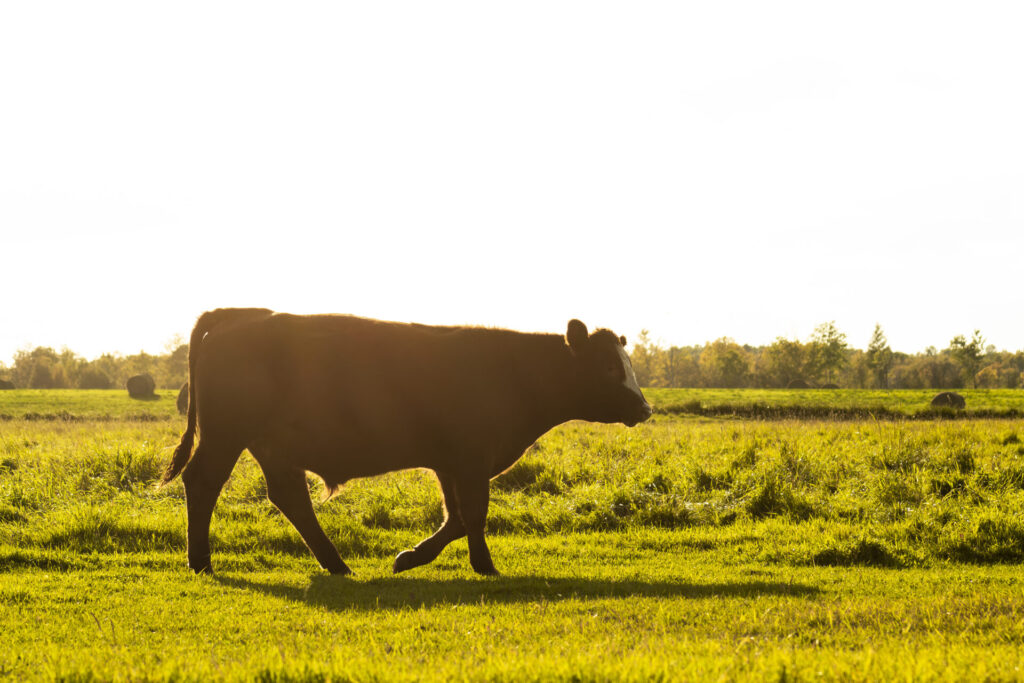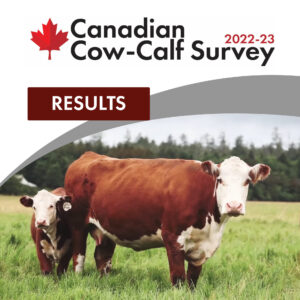Producers Weigh in on Weaning, Preg-Checking and More 🎙️
This article written by Dr. Reynold Bergen, BCRC Science Director, originally appeared in the September 2024 issue of Canadian Cattlemen magazine and is reprinted on BeefResearch.ca with permission of the publisher.
CLICK THE PLAY BUTTON TO LISTEN TO THIS POST:
Listen to more episodes on BeefResearch.ca, Spotify, Apple Podcasts, Amazon Music or Podbean.
Earlier this year we asked you to participate in the industry’s Canadian Cow-Calf Survey. Knowing which production practices producers are adopting in different regions of the country, which they aren’t (and why) helps us target our producer-focused extension efforts better. The official report isn’t out yet, but here’s a sneak peek at some seasonally relevant results.

What We Did
600 producers (managing 95,100 breeding females) responded to our online survey between November 2023 and March 2024. They represent 3% of Canada’s cow herd. For reference, national consumer or voter polls typically target 1,000 to 1,500 responses (about 0.0025% of 39 million Canadians).
What We Learned
Low-stress weaning is becoming more popular in Central and Eastern Canada. The multiple stresses associated with weaning weaken the calf’s immune system and make it more susceptible to BRD. Low stress (e.g., two-stage, fenceline or natural) weaned calves spend less time walking and bawling, and more time resting and eating than abruptly weaned calves (aka “weaning onto the truck”). This helps reduce the risk of BRD. The 2023-24 survey indicated that low-stress weaning was becoming more common in Eastern Canada (55 to 58% of producers, depending on the region, compared to 33 to 46% in the 2017 Atlantic and Ontario Cow-Calf Surveys). Low-stress weaning changed less in Western Canada (44 to 54% of producers in 2023-24, depending on the province, compared to 51% in the 2017 Western Canadian Cow-Calf Survey). Time, labor, facilities, logistics, convenience and lack of economic incentive are the major barriers to adopting low-stress weaning.
Pregnancy checking remains stable. Pregnancy testing and culling open cows can help manage winter feed supplies and costs. Similar numbers of Western Canadian producers pregnancy checked their cows (50 to 70% vs. 62% in 2017) and heifers (56 to 76% vs. 71% in 2017) in spite of drought, feed shortages and high hay prices. Pregnancy checking also remained stable in Central and Eastern Canada for both cows (50 to 55% of producers vs. 49 to 66% in 2017) and heifers (55 to 59% of producers vs. 47 to 64% in 2017). A third of producers who did not pregnancy check felt they were able to visually identify open females. A quarter didn’t see the value in pregnancy checking because they sold their open cows in spring when prices are generally higher. This can be a viable strategy when winter feed supplies and market conditions work in your favor.
More producers are body condition scoring (BCS). Body condition score is one of the simplest and most accurate predictors of cow health and rebreeding performance. In the most recent survey, 69 to 82% of Western Canadian producers reported visually evaluating BCS, up from 64% in 2017. Adoption increased markedly in Central and Eastern Canada (67 to 71% of producers, up from 23 to 50% in 2017). Hands-on BCS scoring remained much lower in both Western (5 to 19% of producers, vs. 13% in 2017) and Eastern Canada (13 to 21% vs. 0 to 26% in 2017). The accuracy of visual BCS goes down as your distance from the cow or the depth of the haircoat increase. If she’s already in the chute to vaccinate or preg check, why not reach through and feel what’s really there?
More producers are using BCS to manage their cows accordingly. Feeding thin, older cows and young growing heifers separately from mature cows in good BCS is a simple way to help them get through the winter in optimal condition. The most recent survey said that 75 to 84% of Western producers used BCS in their cow management decisions (vs. 73% in 2017). Adoption among Eastern producers doubled (60 to 70% vs. 33% in 2017).
More producers are feed testing. Feed testing tells you what the nutrient levels are in the feed you’ve got. More producers in both Western Canada (68 to 79% vs. 60% in 2017) and Central and Eastern Canada (50 to 54% vs. 25 to 34% in 2017) report having tested their feed at least periodically (though not necessarily every year or multiple times throughout the year).
More Central and Eastern Canadian producers are using their feed test results to develop rations. Feed test results are only valuable if they are used to ensure your cattle get the nutrition they need to grow, (re)breed, get pregnant, successfully maintain a pregnancy, and deliver and wean a healthy calf. In Western Canada, 84 to 98% of producers used their feed test results to develop rations (similar to 2017’s 95%). But 76 to 86% of Central and Eastern Canadian producers did so (vs. 29 to 79% in 2017).
Bottom Line
Success often comes from doing the right small things, and from doing the small things right. Your Canadian Beef Cattle Check-Off funds help us develop science-based tools to help you evaluate whether a particular production practice (like the ones listed above) make economic sense for your operation.
So what does this mean… to you?
You don’t control the price of feed and you don’t control the price of calves, but you do control the management decisions you make. Visit www.BeefResearch.ca if you’d like more information on any of the topics discussed above.
The Beef Cattle Research Council is a not-for-profit industry organization funded by the Canadian Beef Cattle Check-Off. The BCRC partners with Agriculture and Agri-Food Canada, provincial beef industry groups and governments to advance research and technology transfer supporting the Canadian beef industry’s vision to be recognized as a preferred supplier of healthy, high-quality beef, cattle, and genetics. Learn more about the BCRC at www.BeefResearch.ca.
Click here to subscribe to the BCRC Blog and receive email notifications when new content is posted.
The sharing or reprinting of BCRC Blog articles is typically welcome and encouraged, however this article requires permission of the original publisher.
We welcome your questions, comments and suggestions. Contact us directly or generate public discussion by posting your thoughts below.
